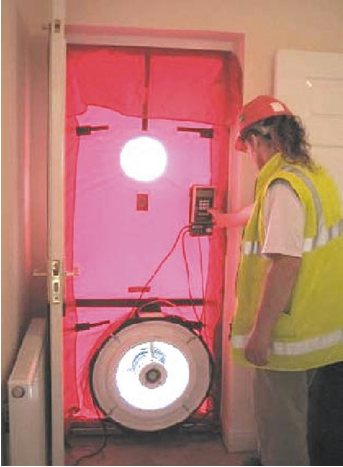2.3.1 Airtightness
Proper airtightness is the key to minimising air infiltration. In existing housing this means using draught-proof strips, replacing leaky windows and blocking unused chimneys. The latter may be difficult since it is often necessary to maintain a small air-flow through them to remove any moisture penetrating into them. It means paying careful attention to blocking all the unwanted air leakage paths shown in Figure 17, while maintaining the essential ones.
In new construction attention to detail is important. It is easy to leave air gaps around windows and where pipes penetrate walls. Sheet plastic vapour barriers are often built into walls, especially in timber-framed construction. For really good airtightness these vapour barriers must be taped together where they join, so that they cover the whole building envelope. This is a highly skilled job.
The overall airtightness of a building can be assessed with a pressure test. Usually one of the external doors is replaced with a frame carrying a calibrated electric fan (see Figure 18). This blows a large amount of air into the building at a known rate, in order to set up a standard pressure difference between the inside and outside of 50 Pascals. This is roughly equivalent to the effects of a gale-force wind. The overall air leakage rate of the building at this pressure difference can be worked out and is usually expressed in cubic metres per hour per square metre of building envelope area (i.e. area of walls, roof, etc.). The lower the figure, the more airtight the construction. Problem areas can be identified and investigated using a small smoke generator allowing the air leakage to be clearly seen.

